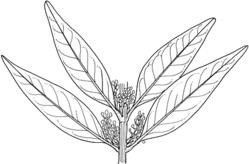Common name: Large Mock-olive, Large-leaved Olive
Notelaea longifolia Vent. APNI* Synonyms: Notelaea longifolia x microcarpa APNI*
Notelaea longifolia x venosa APNI*

Description: Tree to c. 9 m high, often with a dense crown; branchlets grey or brown, usually with conspicuous white lenticels; axillary buds 2–4, pointed, glabrous or hairy.
Leaves variable in size and shape, narrow-lanceolate to broad-ovate, 3.5–16 cm long, 1–5.6 cm wide, apex acute or long-acute or sometimes blunt, base tapering into the petiole; upper surface dark green, lower surface pale, texture stiff, venation conspicuous; petiole 5–15 mm long.
Racemes up to 2 cm long, lengthening in fruit; 5–13-flowered. Calyx 1.5–2.5 mm long. Petals 1.5–2.5 mm long, creamish green. Stamens 1–2 mm long.
Drupe ovoid, 10–16 mm long, bluish black.
Flowering: April–October
Distribution and occurrence: Grows north from Dunoon near Lismore.
NSW subdivisions: NC, CC, SC, CT, ST, CWS, NWS
Other Australian states: Qld
Text by D. W. Hardin
Taxon concept: Flora of NSW 3 (1992)
| | Key to the forms | |
| 1 | Most parts of plant sparsely hairy or pubescent. | 2 |
| Leaves, stems and axillary buds glabrous, rarely with hairs. | f. glabra |
| 2 | Leaves (especially on lower surface), young stems, petioles, axillary buds and rachis of inflorescences pubescent. | f. longifolia |
| Leaves, stems and axillary buds sparsely hairy.
Back to 1 | f. intermedia |
APNI* Provides a link to the Australian Plant Name Index (hosted by the Australian National Botanic Gardens) for comprehensive bibliographic data
***The AVH map option provides a detailed interactive Australia wide distribution map drawn from collections held by all major Australian herbaria participating in the Australian Virtual Herbarium project.
|


